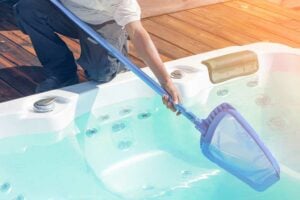The right hot tub chemicals are needed to keep a proper chemical balance so that your hot tub will remain safe and clean to soak and relax in. What chemicals are needed, however? How much of each chemical is needed and when should you add them? How are these chemicals added to your home spa?
Though it may seem confusing, and possibly daunting, at first – relax. It’s not that bad. Taking care of your hot tub is easier once you understand the “how”, “when”, and “what” of spa chemicals.
Are Chemicals Really Needed?
The easy answer here is – absolutely! This is far more complicated than the tub in your bathroom. For months or at least weeks, the water in your home spa will remain in place. It would quickly turn into an incubation chamber without the right chemicals necessary to keep it sanitized. You wouldn’t want to soak in water along with numerous organisms!
There’s more than simple vacuuming of debris and leaves to keep a hot tub clean and sanitary. In addition to potential equipment failure and necessary cleanup work, hot tub-related illnesses can be a result of an improperly maintained spa.
Chemistry for Hot Tubs
Necessary chemicals – Water must be tested in order to determine how much of a chemical to add. At all times, you should have handy either a liquid test kit or test strips. If, for some reason, you don’t have a testing kit, a spa store or a local pool may test a water sample you provide them. The necessary chemicals can be added once you have a baseline reading.
Sanitizers – Where spa chemicals are concerned, sanitizers are an important consideration. The following will help keep your tub sanitized properly. Here are some choices of sanitizers:
- A salt system
- Minerals
- Biguanide
- Bromine
- Chlorine
Adding Chemicals – Depending on the bather load, every week or so, you may need to shock your pool’s system. When needed, this is a super sanitizing procedure. If you wake up to a cloudy hot tub or you notice algae at the bottom, rescue your system with a good shock. The kind of hot tub system you have will determine the type of shock needed.
Alkalinity
Alkalinity is another consideration when discussing hot tub chemistry and the balancing of chemicals. Here, the pH level is a consideration. To keep the pH from drastically changing, alkalinity is necessary. Water can become acidic if the pH level is allowed to get too low. In your chemical storage cabinet, always keep an alkalinity increaser handy.
A PH decreaser can be used if the alkalinity gets too high – which lowers not only pH but alkalinity as well.
Ready to Purchase a Hot Tub?
If you would like to peruse the various selections of hot tubs at AquaVision Pool & Spa, you can do so conveniently and easily on our website. Shop by size, price, or by series. Got questions? Check out our spa FAQ page.
Please feel free to contact us if you have any questions or would like to talk about installing a new hot tub.



 by
by 
